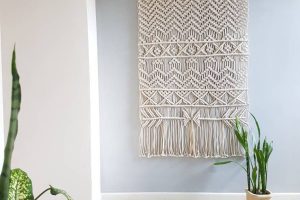Adding a Touch of Tradition: Tapestry Wall Hangings for Modern Homes

Overview of Tapestry Wall Hangings
Tapestry wall hangings have been a cherished form of decorative art for centuries. Originating in ancient cultures, these lovely pieces blend craftsmanship and storytelling through intricate woven designs. Traditionally, tapestries were created to depict historical events, mythical tales, or nature scenes, often serving both aesthetic and functional purposes. Today, these versatile art pieces can brighten any space, from cozy homes to vibrant office environments. Imagine walking into a room adorned with a stunning wall hanging that draws the eye. It not only adds color and texture but also sparks conversations. Their richness lies in the diverse materials used, including wool, silk, and cotton, which gives each tapestry unique characteristics and appeal.
- Adding a Touch of Tradition: Tapestry Wall Hangings for Modern Homes
- Overview of Tapestry Wall Hangings
- The Rise in Popularity
- Incorporating Tradition
- Historical Significance
- Artistic Value
- Choosing the Right Tapestry
- Size and Placement
- Design and Style Options
- Benefits of Tapestry Wall Hangings
- Adding Texture and Depth
- Improving Acoustics
- Where to Buy
- Online Retailers
- Local Stores
- DIY Tapestry Projects
- Customizing Your Design
- Step-by-Step Guide
- Caring for Your Tapestry
- Cleaning Tips
- Storage Advice
The Rise in Popularity
In recent years, tapestry wall hangings have experienced a significant resurgence in popularity, particularly among interior design enthusiasts. Here are some factors contributing to this trend:
- Eclectic Decor: As people embrace more diverse styles, tapestries provide a beautiful focal point that complements various aesthetics, from bohemian to minimalist.
- Sustainable Choices: Many artisans now create eco-friendly tapestries using recycled or organic materials, appealing to environmentally conscious consumers.
- DIY Culture: The rise of social media has encouraged individuals to explore DIY tapestry projects, making it easy for anyone to add a personal touch to their living spaces.
The blend of tradition and modernity makes tapestry wall hangings a perfect choice for anyone looking to enrich their interiors.
Incorporating Tradition
Historical Significance
Tapestries are not just decorative pieces; they hold a profound historical significance that stretches back to ancient civilizations. Considered one of the earliest forms of textile art, they have been used to communicate stories, showcase wealth, and even serve as insulation in chilly castles. Some key points to note about their history include:
- Cultural Narratives: Tapestries often depict historical events or folklore, preserving cultural narratives for generations. For example, the famous Bayeux Tapestry illustrates the Norman Conquest of England.
- Symbol of Status: Historically, owning exquisite tapestries was a mark of prestige amongst the elite. Kings and nobles adorned their castles with these artworks not just for decor but to reflect their power and riches.
Today, many people appreciate these historical pieces for their connection to the past, family heritage, and storytelling characteristics.
Artistic Value
The artistic value of tapestries is another compelling reason to consider incorporating them into your home. Each piece embodies exceptional skill and creativity, showcasing textile design at its finest.
- Craftsmanship: From delicate needlework to bold graphic designs, tapestries combine various techniques, demonstrating the artist’s prowess.
- Color and Texture: The intricate textures and vibrant colors create depth in a room, turning a simple wall into a captivating canvas.
Reflecting on a personal experience, the first time I visited an art gallery featuring tapestries, I was mesmerized by their intricate details and the stories they told. This emotional connection is something every tapestry brings to its viewers, making them a timeless art form that resonates with both history and individual expression.
Choosing the Right Tapestry
Size and Placement
Selecting the right tapestry goes beyond aesthetics; it requires a thoughtful approach to size and placement within your space. Imagine walking into a room where the walls tell a story through art. The right tapestry can truly enhance the ambiance. When considering size and placement, keep the following tips in mind:
- Scale: Large tapestries can act as dramatic focal points, while smaller pieces are ideal for accentuating specific areas. A large tapestry over a sofa can create a statement, while two smaller ones can frame a doorway beautifully.
- Height: Hang your tapestry at eye level, typically 57 to 60 inches from the floor, to ensure it is appreciated by anyone entering the room.
- Room Function: Consider the room’s purpose. A cozy living room might benefit from warm, vibrant tapestries, while a serene bedroom might suit cooler, calming designs.
Design and Style Options
Once you’ve got the size and placement sorted, it’s time to dive into design and style options. Tapestries come in a plethora of designs, accommodating various tastes and home décor themes. Some popular styles include:
- Traditional: Graceful designs often featuring historical or pastoral scenes.
- Modern: Bold geometric patterns or abstract works that bring a contemporary feel to your space.
- Nature-Inspired: Tapestries that celebrate flora and fauna, perfect for creating a serene atmosphere.
Reflecting on my own home, I recently opted for a nature-inspired tapestry featuring a tranquil forest scene, and it has transformed my living room into a peaceful retreat. Choosing the right design can evoke the desired mood, ensuring that your tapestry complements your style while enhancing your space.
Benefits of Tapestry Wall Hangings
Adding Texture and Depth
Tapestry wall hangings are more than just visually appealing; they also serve to enhance the overall texture and depth of a room. Imagine a space where large, flat walls feel bland—this is where a tapestry can work its magic. Adding a textile element creates contrast against hard surfaces like wood or metal, making the environment feel warmer and more inviting. Consider these points on how tapestries contribute to texture:
- Visual Appeal: The intricate weaves and rich fabrics provide a tactile quality that paint and wallpaper simply can’t replicate.
- Layering: Hanging a tapestry allows you to layer different materials and colors, which adds dimension rather than relying solely on color palettes.
- Cozy Atmosphere: Tapestries evoke an immediate sense of comfort and coziness, perfect for creating a welcoming environment.
Improving Acoustics
Beyond aesthetics, tapestry wall hangings can also offer functional benefits, particularly in terms of improving acoustics within a room. Sound reverberation can often create an echo in spaces with hard surfaces. Here’s how tapestries come to the rescue:
- Sound Absorption: The fabric naturally absorbs sound, reducing echoes and creating a more pleasant auditory experience.
- Privacy: Tapestries can provide a sense of intimacy, making conversations feel more private by dampening sound leakage.
Personally, when I added a large tapestry in my open-concept living area, I noticed a significant difference in the overall sound quality. Conversations felt more coherent and the room less echoey, contributing to a comfortable gathering space. The blend of beauty and functionality makes tapestry wall hangings a perfect addition to any home.
Where to Buy
Online Retailers
Once you’ve decided to incorporate tapestry wall hangings into your space, the next step is finding the perfect piece—and thankfully, the digital age has made this easier than ever! Online retailers offer an extensive variety that may not be available locally. Here are some popular online platforms to consider:
- Etsy: A great place to find unique, handmade tapestries from artisans worldwide. You can discover custom designs and support small businesses.
- Amazon: Offers a broad range of tapestries, including both affordable and high-end options. Plus, customer reviews can be very helpful in making your decision.
- Wayfair: Known for home décor, Wayfair has an assortment of tapestries in various styles, from modern to traditional.
I remember the excitement of my first online tapestry purchase; it arrived quickly, and unrolling it was like unveiling a piece of art.
Local Stores
While online shopping offers convenience, visiting local stores provides a tactile experience that can’t be replicated through a screen. Here’s how to make the most of your local hunting:
- Home Décor Shops: Many specialized stores curate a collection of tapestries that reflect local artistry and styles.
- Art Galleries: Some galleries showcase woven art as part of their offerings, providing an opportunity to support local artists.
- Flea Markets or Craft Fairs: These vibrant venues often feature unique, handcrafted tapestries at varying price points.
Exploring local shops can lead to delightful discoveries and gives you the chance to see the tapestry in person, ensuring it fits your vision perfectly. Plus, it’s always fun to chat with shop owners about the pieces and their backgrounds!
DIY Tapestry Projects
Customizing Your Design
Creating your own tapestry is not only a rewarding project but also a chance to personalize your space like never before. Customizing your design allows you to infuse your personality and preferences into your artwork. Consider these avenues for creating a unique tapestry:
- Theme: Choose a theme that resonates with you—be it nature, abstract art, or even a family portrait.
- Color Palette: Select colors that harmonize with your room’s existing décor. Use color swatches to ensure a cohesive look.
- Materials: Experiment with different fabrics, such as canvas, silk, or felt, each offering a distinct feel and texture.
For my latest DIY project, I focused on a botanical theme and printed my own design on fabric, transforming my living space into a mini indoor garden.
Step-by-Step Guide
Ready to dive into your DIY tapestry project? Here’s a handy step-by-step guide to get you started:
- Gather Materials: You’ll need fabric, paints or dyes, brushes, and a canvas frame or dowel for hanging.
- Create Your Design: Sketch your design on paper first. Once satisfied, transfer it onto your fabric using fabric chalk.
- Paint or Dye: Apply your chosen colors carefully, letting layers dry as needed for vibrant results.
- Finish the Edges: Hem the edges or use fabric glue to prevent fraying.
- Hang It Up: Attach it to a frame or dowel, and find a perfect spot to display your masterpiece!
Completing a DIY tapestry not only beautifies your home but also gives you a sense of accomplishment every time you see it on your wall. Embrace your creativity and let your walls tell your unique story!
Caring for Your Tapestry
Cleaning Tips
Once you’ve invested time and effort into choosing or creating the perfect tapestry, it’s important to ensure it remains vibrant and beautiful over time. Cleaning your tapestry may seem daunting, but with the right approach, it can be a straightforward task. Here are some cleaning tips to keep your tapestry looking its best:
- Dust Regularly: Use a soft, lint-free cloth or a feather duster to gently remove dust from the surface. Regular maintenance can prevent dirt buildup.
- Spot Clean Only: For small stains, dab the area with a damp cloth and mild soap. Avoid soaking the fabric, as excessive moisture can damage it.
- Professional Cleaning: If your tapestry is particularly intricate or valuable, consider taking it to a professional cleaner who specializes in textiles.
Personally, I found that just a little dusting every month kept my wall hanging in excellent shape, allowing me to enjoy its beauty without any worry.
Storage Advice
If you need to store your tapestry, proper care is essential to ensure it retains its quality. Here’s how to do it right:
- Roll It Up: Instead of folding, roll your tapestry with a protective layer of acid-free tissue paper to prevent creases.
- Avoid Direct Sunlight: Store in a dark, cool place away from direct sunlight to prevent fading.
- Use a Breathable Bag: Place the rolled tapestry in a breathable cotton or linen bag rather than plastic, which can trap moisture and lead to mold.
Taking these steps not only preserves the beauty of your tapestry but also enhances its lifespan. After all, a well-cared-for tapestry is a legacy that can be passed down through generations, carrying with it the stories of your home.





